If you want to know Recover Lost/Deleted Call History on iPhone X, follow this tutorial to restore lost and deleted iPhone call history without a iTunes backup.
"Have you ever tried to delete the latest phone call by mistake, and you didn't backup it? I am looking for ways to restore call history of iPhone X I just deleted. Can you give me some advice? "
"Before I delete the call history, I backup iPhone to iTunes, and how to restore call history deleted from iPhone X in iTunes backup. "
You May Like:
How to Backup iPhone With and Without iTunes
How to Fix iOS Downgrade Stuck without Data Loss
The call history in iPhone shows the list of input and output call history. Occasionally, iPhone calls history needs to check unanswered phone numbers. These phone numbers have not yet been created as new contacts. Once call history has been erased from iPhone X, you may be in a dilemma, wondering: "how to restore call history on iPhone?"
Restore call history from iTunes (free mode)
Let’s teach you how to restore call history/log from iTunes, please follow these steps:
1.Launch iTunes on the computer and update to the latest version
2.Connect the iPhone X to the computer via a USB cable
3.Click on your device icon on the screen once it appears on iTunes
4.Then, confirm the latest iTunes backup by checking the date and timestamps, and click on “Restore Backup“.
5.Click “Restore” and wait until the restore process is done.
Keep connecting your iPhone device with the computer until it restarts and waits until the restore process done.
Dangerous: The new and existing apps or data/files on the iPhone may be erased if you restore previous data to iPhone X by iTunes, so better create a backup of the new ones or it will be too risky to restore unless you are willing to lose them.
Below, we will teach you an absolutely safe way to recover lost call logs and other data from iPhone X, and you can safely and quickly recover lost or deleted iPhone call history in the three recovery modes: recover data from the device, recover data from iTunes, and recover data from iCloud.
Every iOS user knows that iTunes does not allow you to access or browse the content of iPhone call history, but professional iOS Data Recovery enables you to find, view, and retrieve deleted call history directly from iPhone X, if you have a iTunes or iCloud backup. The missing data can also be selectively extracted and restored deleted files from iPhone backup. With it, you can easily find the call history on iToice, as well as other contents, such as contacts, SMS, photos, videos, notes, WhatsApp, etc.It supports all IOS devices, including the latest iPhone 13. Download the trial version for free.
Use the USB cable that comes with your iOS device to connect your iPhone, iPad or iPod touch, to your computer. Then launch dr.fone on your computer and choose "Recover".
.jpg)
Once the program detects your device, it will show you the window as follows.

Tips: Before running dr.fone, you're supposed to download the latest version of iTunes. To avoid the automatically sync, don't launch iTunes when running dr.fone. I suggest you to disable the automatical syncing in iTunes beforehand: launch iTunes > Preferences > Devices, check “Prevent iPods, iPhones, and iPads from syncing automatically”.
Simply click the "Start Scan" button to let this program scan your iPhone, iPad or iPod touch to scan for deleted or lost data. The scanning g process may last a few minutes, depending on the amount of data on your device. During the scanning process, if you see that the data you're looking for is there, then you can click the "Pause" button to stop the process.

The scan will take you some time. Once it's completed, you can see a scan result generated by the program. Data both lost and existing on your device are displayed in categories. To filter out the deleted data on your iOS device, you can swipe the option "Only display the deleted items" to ON. By clicking the file type in the left side, you can preview the found data. And you can see there is a search box on the top right of the window. You can search for a specific file by typing a keyword in the search box. Then save the data to your computer or your device by clicking the recovery button.
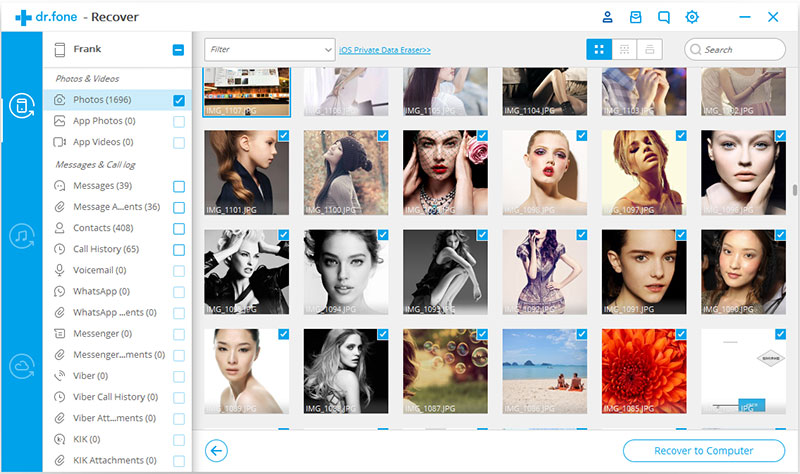
When you find the data you need, just put the check mark in front of the box to select them. After then, click the "Recover" button at the bottom right of the window. By default, the recovered data will be saved to your computer. As for text messages, iMessage, contacts, or notes, when you click Recover, a pop-up will ask you to "Recover to Computer" or "Recover to Device". If you want to put these messages back to your iOS device, click "Recover to Device".
Launch dr.fone and click "Recover".
.jpg)
Then choose "Recover iOS Data".

You can see three options on the side here. Choose "Recover from iTunes Backup File". After then, the iTunes backup recovery tool will detect all iTunes backup files on this computer and display them in the window. You can confirm which one is the one you need according to the date it has been created.

Choose the iTunes backup file that contains the data you want to recover and click "Start Scan". It will take a few minutes to extract all data from the iTunes backup file. Be patient.
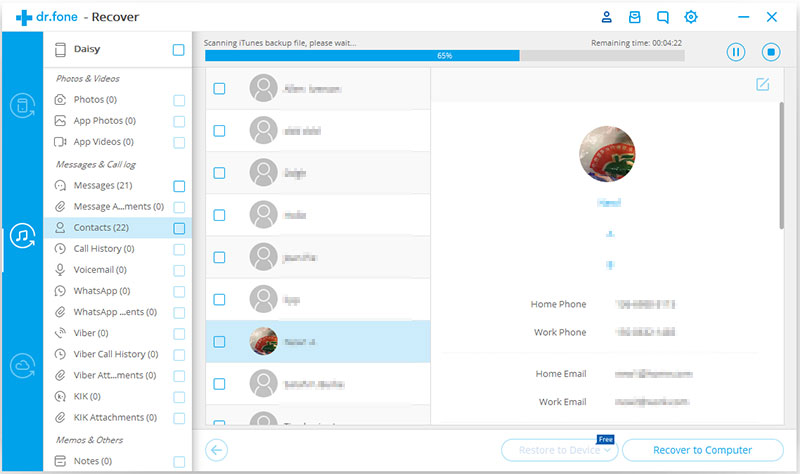
After a few seconds, all data in the backup file will be extracted and displayed in categories. You can preview them one by one before recovery. Then you can selectively mark and recover those you want by pressing the "Recover" button at the bottom. Now contacts, notes and messages can be directly recovered to your iOS device if you keep your iOS device connected with your computer via a USB cable during the recovery process.
Tips: you can see there is a search box in the result window. From there, you can type in the name of a file to search for it.
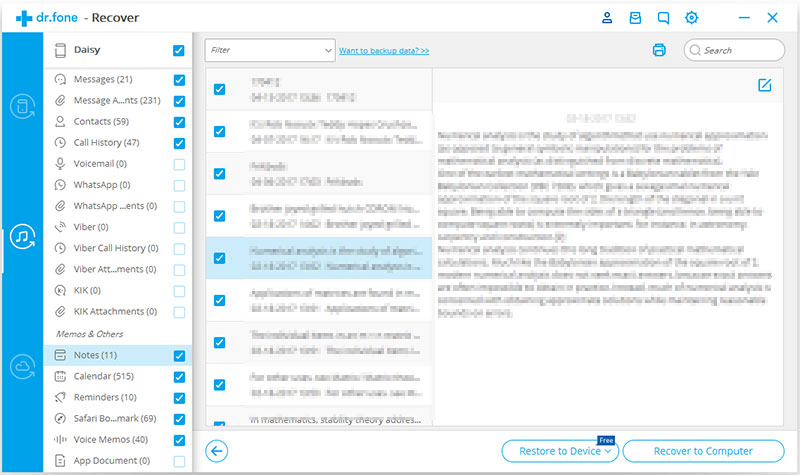
When your iTunes backup file comes from somewhere, such as moved from another computer with a USB drive, how can you preview and get the content from it? There is a way. When you are at the first step, click "Select" under the list of iTunes backup files, and you can flexibly choose the iTunes backup file no matter where you place it.
.jpg)
Then in the pop-up window, preview and target your iTunes backup file. Then click "Start Scan" and you can move on with the step 2 above. It's pretty useful feature.

After running dr.fone, choose "Recover" and click on it.
.jpg)
Then choose "Recover iOS Data".
.jpg)
After that, you can see there options for you to do data recovery. Choose "Recover from iCloud Backup Files". Then you'll see the window below. Enter your iCloud account and password to login. dr.fone takes your privacy seriously. We never keep a record of any your Apple account info or content at any time during your sessions.
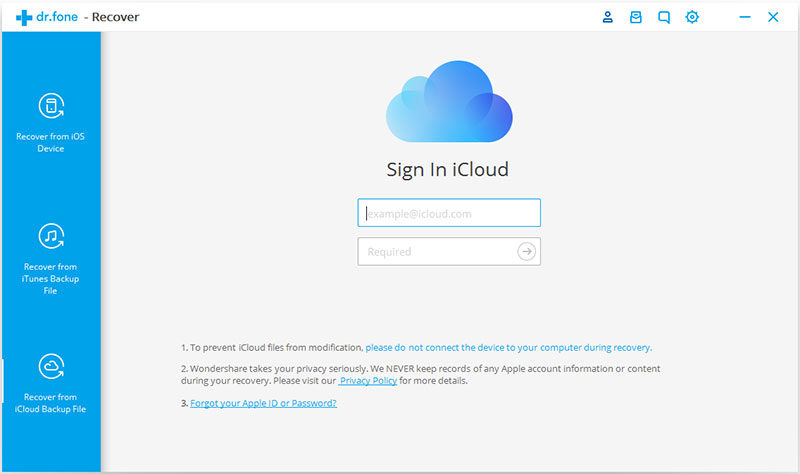
When you logged into iCloud, the program can find all iCloud backup files in your account. Choose the one where you're going to recover data and click on the "Download" button.
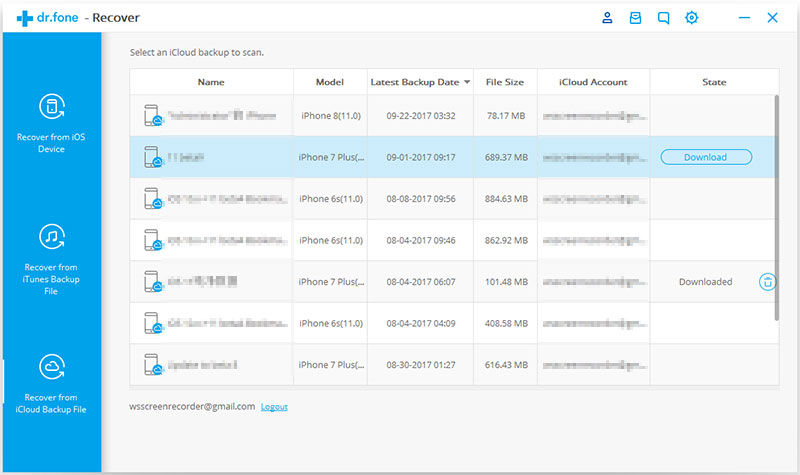
And then in the pop-up, you can choose the type of files you would like to download. This will reduce the time of downloading the iCloud backup file. After that, you can scan the iCloud content now. Click on the "Next" button to start downloading. It will take you some time. Just wait for a moment.
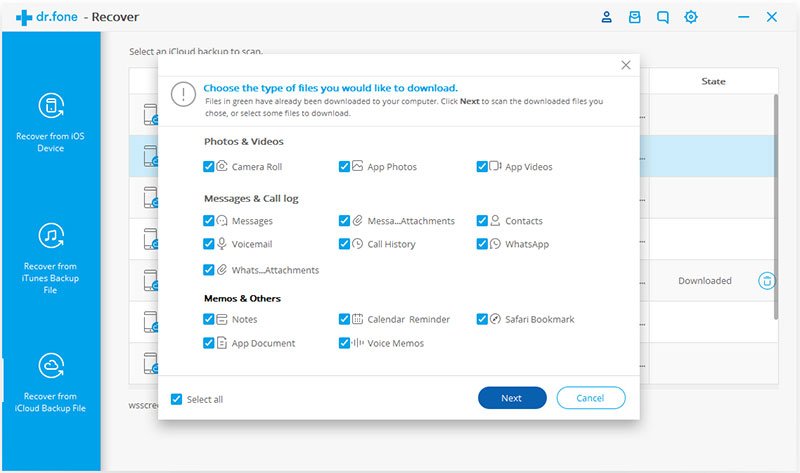
The scan will be complete in a few minutes. Once it stops, you can preview almost all data in your iCloud backup file, like contacts, messages, photos, and more. Check them one by one and tick the item you want. Then click on the "Recover to Computer" or "Recover to your device" button to save them on your computer or your device with one click.
Now contacts, messages and notes can be directly recovered to your iOS device if your iPhone, iPad or iPod touch is connected with your computer with a USB cable during the recovery process.
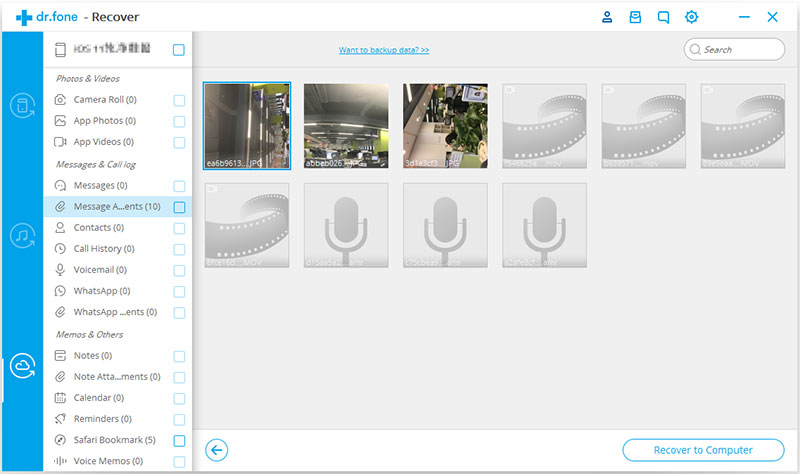
If you have downloaded iCloud backup files previously, you don't need to sign in and get off the iCloud backup file again. Click "To preview and scan previously downloaded iCloud backup file" under the account sign-in entrance.

Then you can see all downloaded iCloud backup files displayed in a list. You can choose any of them to extract the content. All these downloaded backup files are located on your own computer. If you don't need them any more, you can click on the trash icon beside the scan button to delete them completely.


